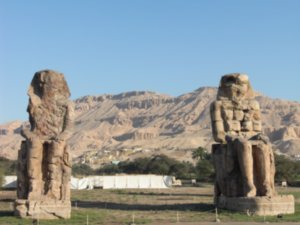Advertisement
Published: July 17th 2008

 Colossi of Memnon
Colossi of Memnon
The twin statues depict Amenhotep III (fl. 14th century BC) in a seated position, his hands resting on his knees and his gaze turned eastward toward the river and the rising sun. Two shorter figures are carved into the front throne alongside his legs: these are his wife Tiy and mother Mutemwiya. The side panels depict the Nile god Hapy.Twelfth & Thirteenth Stop: Valley of the Kings & Luxor:
Next along the Nile river was the fabled Valley of the Kings. Before entering the valley, we stopped at the Colossi of Memnon and Hatshepsut's memorial temple. The actual Valley of the Kings is a region where 500 years worth of Pharaohs and nobility from the "New Kingdom" were buried (16th - 11th century BC). The mummies of some of the most famous Pharaohs, including King Tutankhamun and Ramses II were discovered here. After years of theft from above ground monuments (i.e. the Pyramids), the Pharaohs decided to create their lasting monuments underground.
The Egyptians take the "No Photo" rule seriously. Ryan was snapping away inside the first tomb and this elderly Egyptian man asked him to show him the camera and he just took it! I tried to pay the guy off but he was having none of it. Ryan paced back and forth nervously while I started my way back up to the entrance. One of the guys on our tour got the bright idea of cutting all the power in the tomb (hot, pitch black and filled with people) to freak the guy out and convinced

 Hatshepsut's Memorial Temple
Hatshepsut's Memorial Temple
Hatshepsut is one of the most famous female Pharaohs ruling during the 15th century B.C. him to give Ryan back his camera if he could turn the power back on. Absolutely classic!
Across the river from Valley of the Kings is Luxor (ancient Thebes). In the reign of Rameses III, more than two thirds of the property owned by the temples belonged to Amun, evidenced by the stupendous buildings at Karnak. Although badly ruined, no site in Egypt is more impressive than Karnak. It is the largest temple complex ever built by man, and represents the combined achievement of many generations of ancient builders. This vast complex was built and enlarged over a thirteen hundred year period.
Advertisement
Tot: 0.076s; Tpl: 0.011s; cc: 9; qc: 47; dbt: 0.0474s; 1; m:domysql w:travelblog (10.17.0.13); sld: 1;
; mem: 1.1mb

 Colossi of Memnon
Colossi of Memnon
 Hatshepsut's Memorial Temple
Hatshepsut's Memorial Temple
